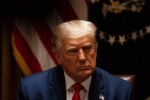Trump’s Panama Canal plan is another loser for America’s maritime industry
Less than 30 minutes into his second term, President Trump abandoned the pretext of isolationism he had adopted during his campaign and laid out the first steps for a 21st-century expansion of the American empire. His target? The Panama Canal.
Trump tapped into a familiar set of grievances in his inauguration speech as justification for taking back the waterway, claiming that “American ships are being severely overcharged.” He also claimed, despite Panamanian denials, that China was surreptitiously operating the canal.
Like many of Trump’s claims, this one is off-base. Although there are concerns about the Chinese government’s involvement in infrastructure projects near the canal, China has no control over the canal itself.
But China does have the power to cripple U.S. shipping and our access to key supply chains — and it doesn’t need the Panama Canal to do it.
Starting about 45 years ago, the U.S. government began abandoning polices that had, going back to colonial times, ensured that that America maintained a viable shipbuilding industry and merchant marine. But in the 1980s and ’90s, the U.S. abandoned these policies in favor of a radical free-market approach. Meanwhile, China and peer nations continue to © The Hill






















 Toi Staff
Toi Staff Tarik Cyril Amar
Tarik Cyril Amar Andrew Mitrovica
Andrew Mitrovica Sharona Margolin Halickman
Sharona Margolin Halickman Rachel Marsden
Rachel Marsden Patrick Gathara
Patrick Gathara Belen Fernandez
Belen Fernandez Gideon Levy
Gideon Levy Alexey Kupriyanov
Alexey Kupriyanov
